| Photo |
Tools
name |
Description
/ Application |
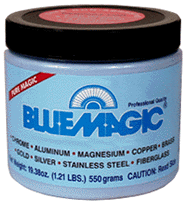 |
Blue
Magic |
Use Blue magic to
polish clear plastic canopies, windscreens, etc. in airplanes, cars, helicopters
etc. It can also be used on painted surfaces. |
How to use Blue Magic :
 Wet-sand the clear plastic or paint finish. Start with 320 grit sandpaper and work
up through the various grits to 2400. Change the water each time you switch from one grit
to the next ( i.e., 320 to 600, etc.) Soak your sandpaper in water for 2-3 days prior to
using it.
Wet-sand the clear plastic or paint finish. Start with 320 grit sandpaper and work
up through the various grits to 2400. Change the water each time you switch from one grit
to the next ( i.e., 320 to 600, etc.) Soak your sandpaper in water for 2-3 days prior to
using it.
 When finished with the 2400 grit,
rinse all dust from the model and dry off the water by blotting gently with tissue. When finished with the 2400 grit,
rinse all dust from the model and dry off the water by blotting gently with tissue.
 Begin to polish out the plastic
or paint with Blue Magic, using "Q Tips" and a clean, soft cotton cloth ( i.e.,
and old T-shirt or a new cotton sock). Apply a little Blue Magic at a time, gently buffing
out the surface with a clean portion of the cloth until a luster appears. Begin to polish out the plastic
or paint with Blue Magic, using "Q Tips" and a clean, soft cotton cloth ( i.e.,
and old T-shirt or a new cotton sock). Apply a little Blue Magic at a time, gently buffing
out the surface with a clean portion of the cloth until a luster appears.
 Check for scratches that may mar
the surface. Re-sand the area of the scratch starting with 600 grit paper and move up
through the 2400 grit paper. Then re-polish with Blue Magic until you acquire a
blemish-free finish. Check for scratches that may mar
the surface. Re-sand the area of the scratch starting with 600 grit paper and move up
through the 2400 grit paper. Then re-polish with Blue Magic until you acquire a
blemish-free finish.
 The type of silicon in Blue Magic
helps protect the finish, but it won't inhibit the application of paint. Simply clean the
surface to remove finger prints and excess polish, then apply paint over the finish as
desired to create accent stripes, details or other special effects. The type of silicon in Blue Magic
helps protect the finish, but it won't inhibit the application of paint. Simply clean the
surface to remove finger prints and excess polish, then apply paint over the finish as
desired to create accent stripes, details or other special effects.
Courtesy from Micro-Mark -
Instruction for Blue magic. MM 0495
|
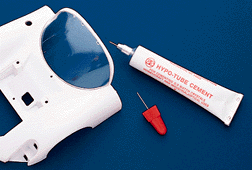 |
Watch
crystal cement |
Ideal for
cementing clear plastic. |
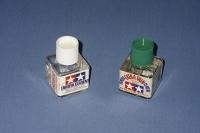 |
Plastic
cement |
Tamiya -
extra thin / Normal |
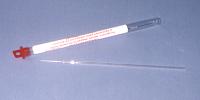 |
"Touch-n-Flow" |
The
applicator specially designed for the precise control of liquid solvent
plastic cements and C/A activators.
Stand open end of glass tube in open bottle of liquid solvent plastic
cement or C/A activator. Watch liquid rise in the tube as it stands on
end. If liquid does not rise in glass tube try flicking end of metal tube
with a slight springing action to get it started. Allow to stand long
enough to fill glass tube to the depth of liquid in bottle. If
liquid is at a low level in cement bottle, you may want to tip bottle
slightly to allow more liquid to rise in glass tube. Allow the glass
tube to fill approx. 1" - 1 1/2" with liquid.
A few hints for liquid cement application :
First, apply a line of liquid cement by dragging the applicator tip on a
piece of paper or card stock. Always drag, never push the tiny tip into
your work...The best position for the "Touch-n-flow", when not
in your hand, is lying FLAT on your work surface. If a plastic residue
builds up on the tip and stops the flow, wipe clean with tissue after
dipping tip in liquid solvent cement. If flow does not start
immediately, dip again and drag tip on a piece of paper to restart flow.
CAUTION
:
Handle with care, this tool is made of glass and is breakable.
Keep out of reach of children.
|
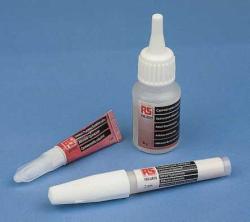 |
Cynoacrylate
Adhesives
General purpose |
nickname
Superglue, suitable for use with metals, most plastics,
ceramics, epoxy. |
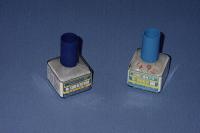 |
Mr.
Surfacer |
Gunze
Sangyo 1000 / 500 |
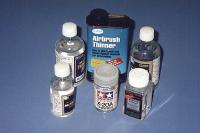 |
Thinners |
From :
Tamiya, ModelMaster and Gunze Sangyo |
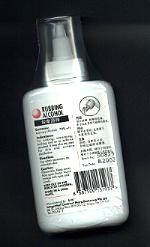 |
Isopropyl
Alcohol |
A fast way
to clean the model before painting |
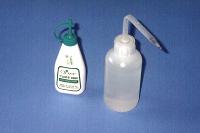 |
White
Glue |
Use for
temporary holding of small parts. |
| |
Masking
Tape |
Mask off
portion while during painting or air-brushing |
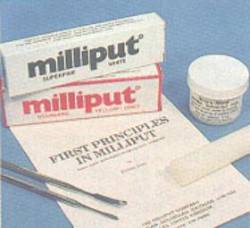 |
Milliput
Putty |
Milliput
is the two part, easy-to-use putty that molds like clay and cures to the hardness of
porcelain. Use for scratch building, sculpting, repairing, gap filling, pattern making and
customizing. Ideal for military miniatures, ship model parts, plastic models and thousands
of other items.
Roll it as thin as 1/64" for making super detailed scale parts. Can be sawn, drilled,
filed, sanded and painted when cured. Smoothes with a wet finger and cleans up with water
before it cures. Fully cured in 5 hours without heat or sooner with a hair-dryer. The
choice of master model makers throughout the world.
Courtesy from Micro-Mark
|
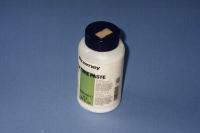 |
Artiste
Paste |
Use it for filling up the gap in the
ceramic building, or simulate as mud, ( while mix with earth color ) apply on vehicle. |
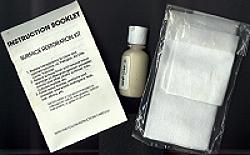
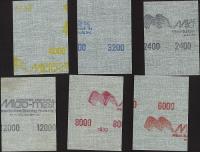 |
Surface
Restoration
Kit |
Restore
transparency to clear and color acrylics, .i.e. Plexiglas, Acrylite, Lucite, Polycast.
Restore surface finish and remove minor damage on fiberglass gel coat, polyester, acrylic
and other plastic surfaces; tubs, cultured marble, etc.
Polish wood finishes, urethane and polyester, and wood; mahogany, teak, oak, ebony, etc.
This kit comes with :
1 bottle of Micro-glass abrasive paste
1 foam block
1 instruction booklet
1 each, sand paper 2400,3200,4000,6000,8000,12000
A few of 100% cotton flannel
Courtesy of MICRO-MESH
|
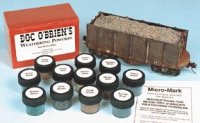 |
Doc
O'Brien's
Weathering
Powders |
This
set of powders let you create an old, weathered appearance on scale
vehicles, military models, trains, figures and aircraft. The ultra fine
powders are dusted on to simulate the effects of time and the elements.
They're also used as weathering washes when mixed with water. Instructions
included, non-toxic.
Twelve color set includes Dirty Brown, Mildew Green, Grimy Black, Gritty
Yellow, Rusty Red, Faded Blue, Rusty Brown, Grungy Gray, Patina Green,
Desert Sand, Highlight White and Muddy Red. |